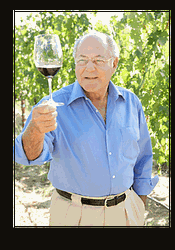Tony Terlato says Syrah will make a comeback. You have to listen to Terlato; this is the man who introduced Pinot Grigio to the US. Not only that, he says his company, which both imports and produces wine, is responsible for one of every eight bottles sold over $14 in the US.
But at 77 years old, Terlato will need some luck to see Syrah shed its current image as the most cobwebbed section of the wine shop.
"Most people are jumping off Syrah," Terlato says. "In 8 or 10 years we’ll be happy with what we have. There’s too many good people making it."
be happy with what we have. There’s too many good people making it."
I have my own opinion on why Syrah has fallen to the bottom of many a wine list: Its character is unpredictable, and wines that aficionados like best have a gamy character that novices don’t enjoy.
Terlato’s take is different.
"I believe they weren’t so popular because of the very high alcohol," he says. "If you have 15.5 (percent) on the label, it could be 16.5. They always opted for the higher. I believe that at 14 (percent) alcohol, Syrah can be much more interesting."
Interesting to whom? Terlato believes that wineries have been selling Syrah to the wrong people. In California, Syrah tends to thrive in the same places as Pinot Noir and be made artisanally by some of the same producers. But Terlato thinks these Pinot producers’ fans are not Syrah’s potential customers.
"Syrah fits the taste profile of the Cabernet drinker," Terlato says. "Not necessarily those who like Pinot Noir. But Syrah, like Pinot Noir, stands on its own. Syrah has the heft of Cabernet with the delicacy of Pinot Noir. If you taste 10 Cabs, there’s a narrow range of flavors. If you taste Syrahs, a broad range comes up."
Terlato is heavily invested in Syrah on four continents. His portfolio contains earthy, elegant wines like Michel Chapoutier’s from France and bruisers like Two Hands from Australia.
One of his most interesting wines combines the two cultures. He has a joint venture with Chapoutier in Australia’s Pyrenees region, a mountainous area (duh!) northeast of Melbourne that is barely known north of the equator.
"Michel keeps an envelope (for dirt samples) in his pocket and when he sees something he likes, he’s scoops some out, puts it in the envelope and takes it home to France to analyze it," Terlato says. "My son was with him in Australia when he scooped it. He got home and he called and said, ‘I found soil I can make wine with in Australia.’ I said, ‘Great.’ He said, ‘I want to be partners with you on this.’ So we’re partners."
Like Terlato, Chapoutier is no dummy; partnering with Terlato allowed him to split the expense of buying 500 acres, of which only 100 were plantable.
"It’s all slopes and ravines. You can’t walk up and down those slopes. It’s hard to farm," Terlato says. "But we had to buy the land to get the soils Michel liked. You didn’t hear of the Pyrenees before, but it’s becoming known now. The Malakoff vineyard, the Shiraz/Viognier, the first year made the (Wine Spectator) top 100. Now the land around that vineyard is starting to sell."
Talk about contrarian: Terlato is betting not only on Syrah, but also on Australia, which has seen declining wine sales because consumers balk at paying more than they do for Yellow Tail or the Little Penguin.
"Australia will come back," he says. "It might take 10 years, 15 years. The problem with Australia has been that all the wineries were corporate-sounding. They didn’t have a passion for wine. It was a business and it all had to do with money. They had to show quarterly results. Then came this new group of people who are interested in quality. It’s turning around, but you have to be patient. My granddaughter is 25. In 15 years she’ll take advantage of those great Australian wines."
In fact, Terlato believes that his granddaughter and her friends will change much about the way wine is sold.
"When my son went to college, his friends were drinking pitchers of beer," he said. "When my granddaughter went to college, she and her friends would put in $10 each and go to dinner and drink a $60 bottle of wine. Kids today are thirsting for knowledge. Look how many wine books there are today that didn’t exist 25 years ago. Abbott Laboratories and companies like that are sending kids to Europe for a month and buying them books to learn about wine. If you’re a top executive and you take somebody out to dinner and you can’t order a bottle of wine, you lose a couple of points. Companies want their executives, when they entertain, to be able to fluidly order."
We talked for a long time about Syrah, but Terlato’s import portfolio is so impressive, with top wines from Italy like Angelo Gaja, top Champagnes like Bollinger plus some of his own wineries in California like Sanford. As he’s been in the business for 40 years, I can only imagine what his cellar is like. I had to ask, what’s your favorite thing to drink right now?
"I have an answer for that," Terlato says. "It’s whatever I’m drinking."
